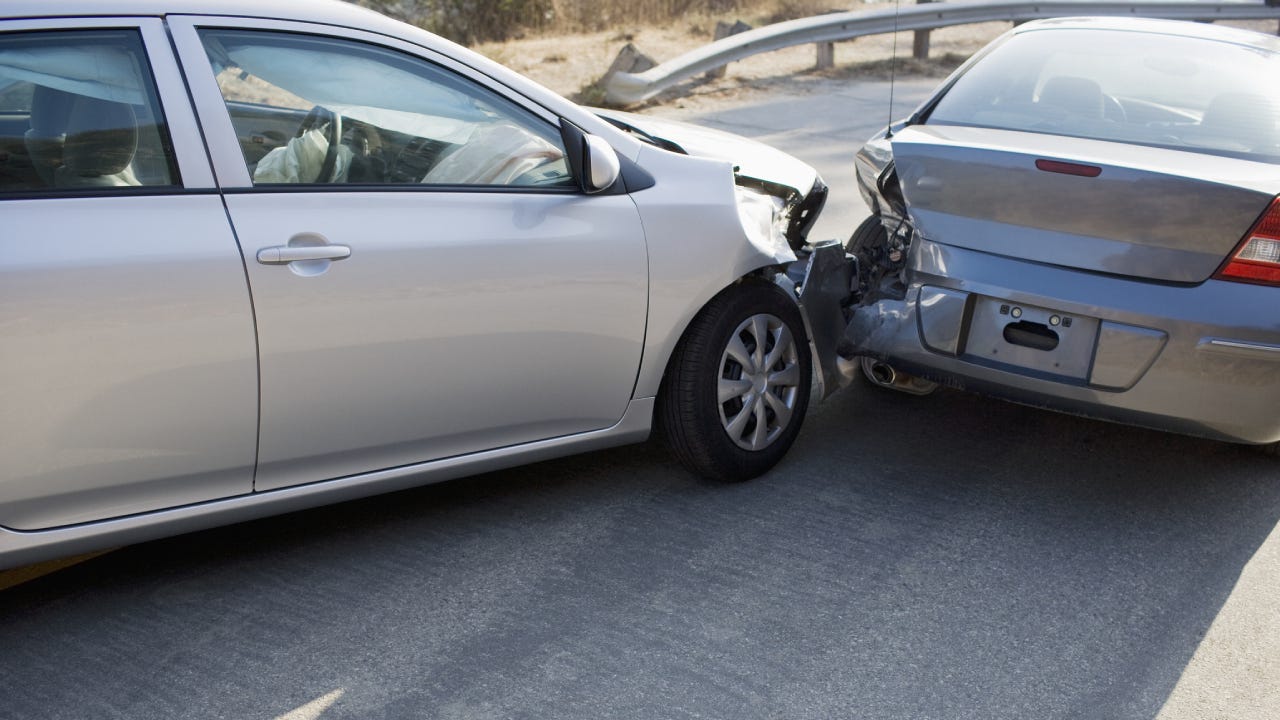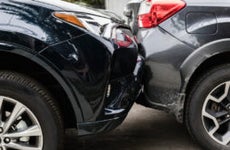What does no-fault state mean?

The Bankrate promise
At Bankrate, we strive to help you make smarter financial decisions. To help readers understand how insurance affects their finances, we have licensed insurance professionals on staff who have spent a combined 47 years in the auto, home and life insurance industries. While we adhere to strict , this post may contain references to products from our partners. Here's an explanation of . Our content is backed by Coverage.com, LLC, a licensed entity (NPN: 19966249). For more information, please see our .
Car insurance aims to offer financial protection if you are involved in a car accident, but how your claim is paid and by whom isn’t the same for all drivers. A driver’s negligence can influence claim payouts, and the laws determining negligence vary between states. States are generally categorized into two insurance systems — no-fault and at-fault — which strongly impact the type of coverage you need on your car insurance policy and how your claim is paid. Bankrate’s insurance editorial team can help you learn the difference between an at-fault accident and an at-fault state so that you feel more comfortable with the claims process if you are involved in one.
Accidents in at-fault states vs. no-fault states
There are numerous car accident scenarios that can take place, and while each accident may be unique, there are standardized ways of handling the aftermath. The claim will be handled according to the state’s fault laws. Currently, 12 states follow no-fault insurance laws, with the remaining states and Washington, D.C. being considered at-fault states. In a no-fault state, both parties will file a claim with their own insurer to help pay for their own injuries, regardless of who is at fault. The insurance company of the driver who caused the accident will also be responsible for paying for property damage expenses of both parties. In an at-fault state, all claim expenses, including injuries and property damage, are the responsibility of the at-fault driver.
Accidents in at-fault states
In an at-fault state, also called a tort state, a driver who causes a car accident is responsible for compensating the other party or parties for their losses.
The property damage liability portion of your policy pays for the other driver’s vehicle damages and your bodily injury liability insurance is designed to pay for the other driver’s and passengers’ medical expenses if they are injured. These coverage types will only pay up to the limits on your policy and any overage is your responsibility to pay out of pocket. Depending on if you have full coverage, your insurance policy might also pay for the damages to your car. If you have PIP or medical payments coverage, your policy can also help pay for your injuries and the injuries of your passengers, up to your policy limit.
Accidents in no-fault states
No-fault states operate a system of laws that allow people to receive necessary medical treatment immediately following an accident. Contrary to the name, fault does still exist in no-fault states. No-fault insurance only refers to injuries that occur in accidents. Drivers are still liable for the property damage they cause if they hit someone, as well as the medical payments if the injury amount surpasses the state-regulated threshold.
After an accident in a no-fault state, both drivers’ insurance companies will pay for their respective insured’s medical expenses using their PIP coverage, regardless of which driver caused the collision. However, the at-fault driver is responsible for compensating the other driver for their car repairs using property damage liability coverage. While every state is different, no-fault states generally do not allow injured parties to sue for non-economic damage unless the injury meets the state’s definition of a severe injury. The 12 states that have no-fault insurance laws are:
- Florida
- Hawaii
- Kansas
- Kentucky
- Massachusetts
- Michigan
- Minnesota
- New Jersey
- New York
- North Dakota
- Pennsylvania
- Utah
Choice no-fault states
Three states allow policyholders to choose between a no-fault type of insurance policy and a standard tort policy. Drivers who choose a limited tort policy typically pay a lower premium because they limit their right to sue for non-economic losses. However, drivers who choose the full tort option retain the ability to sue for monetary and non-monetary losses. States that offer this option are:
- Kentucky
- New Jersey
- Pennsylvania
Accidents where you are not at fault
So how does car insurance work when you are not at fault for an accident? In the event of a not-at-fault accident, meaning an accident you did not cause, the claim will be handled based on the state’s fault laws. Remember that a not-at-fault accident and no-fault accidents are two separate things; not-at-fault accidents happen in both no-fault and tort states.
If you get hit by another driver in a no-fault state, your PIP coverage is designed to pay for your injuries and, typically, the injuries sustained by your passengers up to your policy limit. It may also pay for lost wages if you cannot work and for the expenses associated with hiring someone to handle household tasks that you cannot complete while injured. The at-fault driver’s car insurance should still cover the cost of your vehicle’s repairs.
If you get hit by another driver in an at-fault state, the at-fault driver’s car insurance should pay for your medical bills and vehicle repairs. However, in tort states, you may still have the option to purchase PIP coverage or medical payments coverage. These options will pay for your medical bills and, usually, the bills of passengers in your car who were injured, regardless of who caused the accident. If your insurance company issues a payout under these coverage types, it will likely work to be reimbursed by the at-fault driver’s company in a process called subrogation.
Car insurance and negligence
When it comes to car accidents, it is not always clear which driver was responsible. Some accidents are complex, and fault is not always obvious. In situations where both drivers are partially at-fault, insurance companies will usually look at the amount of negligence that each driver had.
Negligence typically falls into three categories — pure contributory, pure comparative and modified comparative. Every state has a different definition of negligence, so where you live and the amount of responsibility you assume in an accident will both impact how your claim is handled.
-
-
In states that follow pure contributory negligence rules, parties who are even 1 percent at fault cannot claim damages from the accident. These states include:
- Alabama
- Maryland
- North Carolina
- Virginia
- Washington, D.C.
-
In states that follow pure comparative negligence guidelines, all parties involved in an accident are able to claim damages regardless of what percentage of fault they’re responsible for. However, their payout will be reduced by their level of fault. For example, a driver who is 80 percent at fault may only claim damages for the 20 percent fault of the other driver.These states include:
- Alaska
- Arizona
- California
- Florida
- Kentucky
- Louisiana
- Mississippi
- Missouri
- New Mexico
- New York
- Rhode Island
- Washington
-
States with modified comparative negligence rules only allow drivers to claim damages if they are under a set threshold of fault, either 50 percent or 51 percent, depending on the state. Drivers would have to fall under their state’s respective threshold of fault in order to be eligible for compensation.These states include:
- Arkansas
- Colorado
- Connecticut
- Delaware
- Georgia
- Hawaii
- Idaho
- Illinois
- Indiana
- Iowa
- Kansas
- Maine
- Massachusetts
- Michigan
- Minnesota
- Montana
- Nebraska
- Nevada
- New Hampshire
- New Jersey
- North Dakota
- Ohio
- Oklahoma
- Oregon
- Pennsylvania
- South Carolina
- Tennessee
- Texas
- Utah
- Vermont
- West Virginia
- Wisconsin
- Wyoming
-
How is fault determined in a car accident?
The details of each accident will vary, but the process of determining fault after an accident is usually the same. In an at-fault state, fault is determined by the party that caused the accident. The drivers involved in a car accident may also discuss fault at the scene of the incident and in some cases, a driver admits guilt.
- The police will analyze the scene to try to understand who is at fault. This may involve making a diagram of the incident and note the extent and location of vehicle damage on the police report.
- The report will be shared with the drivers’ car insurance companies to review. Your car insurance company will decide which claims your policy fulfills and which ones it does not.
- Each insurance company will get statements from both drivers involved in the accident. Your insurance company will seek a payout from the other driver’s insurance provider if the other party involved is the at-fault driver.
Frequently asked questions
-
-
It is likely that your car insurance rate will increase after an accident, especially if you were the one responsible. The amount that your insurance premium will increase depends on the severity of the crash, your existing claim history and your insurance company. If you have accident forgiveness, your insurance company might waive the premium increase after your first collision.You may see your premium increase for a not-at-fault accident if you lose a claim-free discount or your policy is re-evaluated by your company. Each company has different guidelines regarding accident forgiveness programs, so talking to an agent might help you understand how your company’s policy functions.
-
The best car insurance company is different for every driver. It depends on where you live, what type of coverage you need, how much you can afford to spend and what discounts you qualify for. Drivers with DUIs or who have several accidents or speeding tickets may find better rates with car insurance companies that specialize in high-risk drivers, and older drivers may benefit from companies that offer a discount for being a senior citizen. If you are shopping for car insurance, understanding what you are looking for in a company and getting quotes from several providers could help you find the best option for you.
-
In the United States, the average cost of car insurance is $2,542 per year for a full coverage policy and $740 per year for a minimum coverage policy. However, keep in mind that every driver pays a different rate for coverage. Some of the factors that impact your car insurance premium are your claim history, the type of car you drive and the amount of coverage you need. In most states, your age, gender and credit score also impact your premium, although some states ban the use of one or all of these rating factors.
-
The at-fault driver still pays for property damage in a no-fault state, and that includes damage to vehicles. This means that if another driver hits you and is determined to be at-fault, they are still liable for your damages. No-fault coverage only refers to injuries.
-
Related Articles



